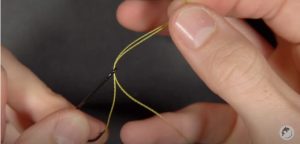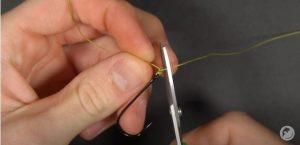WHATS A PALOMAR?
The Palomar tie (/ˈpæləmɑːr/PAL-ə-defaces) is a bunch that is utilized for getting a fishing line to a fishing lure, snap or turn.
Steps in tying a Palomar tie (free end is hued red).
- Tie the free overhand bunch.
- Pass the item through the excess loop.
- Begin cozy.
- Finish cozy (pull equitably on standing closures).
- Perspective on front side.
To tie the bunch first twofold 8-12 crawls of line into a loop and pass it through the eye of the hook, lure or turn. Tie an exceptionally free overhand bunch utilizing the multiplied loop and the multiplied part of line driving back to the casting pole. Pass the item to be tied through the leftover loop of the overhand bunch and slide the loop up onto the line simply over the eye of the hook. Dampen the bunch to reduce the contact and pull on the tag and standing finishes equally to cozy the bunch down. Trim the free stopping point to a length of around 3mm.
This bunch is great for a wide range of light fishing lines, particularly braided Dacron, and holds practically all of the first line strength, even with monofilaments. It additionally is almost inconceivable (if tied accurately) to “pull out”. It is similarly successful with other securing applications -, for example, a canine clasp to a rope – gave the article being tied to can pass through the loop, and the line or rope isn’t too thick to even consider passing through the item two times, and, with practice, it tends to be tied in obscurity with cold hands
HOW TO TIE A PALOMAR KNOT

Information on fishing bunches and where they might be best used is as yet one of the most valuable ranges of abilities for anglers, even with the present current fishing lines, Regardless of whether dropping, projecting, or genuinely any fishing, the right information on fishing hitches is a strong weapon for your armory.
The Palomar Knot is a moderately basic and clear bunch that can be depended upon in extraordinarily predicaments. It is a top pick among all degrees of angler to get hooks, lures, turns, and snaps to the furthest limit of their lines – or a fly to a pioneer or scarf.
The bunch copies the line around the areas that go under the most strain giving it much added strength. Tying this bunch wrong however can regularly prompt cutting your line. To assist you with staying away from such issues we have assembled this fast manual for understanding and dominating this basic however powerful fishing hitch.
Palomar Knot Tying Instructions

Make a loop with the end of the line and pass it through the eye of the hook. For small hook eyes, on the other hand, pass the end of the line through the hook eye once, then turn around and run the end of the line through the hook eye again from the inverse bearing, leaving about six crawls of multiplied line outside the hook eye.
- Make a free overhand bunch by swinging the hook from the base.
- Pass the loop of line over the hook while holding the overhand bunch between the thumb and pointer. Slide the loop above the hook’s eye.
- To secure the hitch onto the eye, pull on both the standing line and the label end. Close the label end.
PALOMAR FISHING KNOTS

While figuring out how to fish you will get familiar with some fundamental fishing hitches like the Palomar tie. A few fishermen think Palomar ties are the best kinds of fishing bunches to use for light fishing lines, (for example, braided lines, which won’t pull out of this bunch like it can with different sorts of bunches) since they hold a lot of their unique line strength. Master tying a fishing tie that is simply difficult to tie however shrewdly intended to tie down your chief to your fishing hook or a turn.
PALOMAR KNOT BENEFITS
The Palomar tie strength is 95%, which is remarkable.
Palomar hitches are compelling bunches to use for fishing lines as much as a 20-pound test.
This bunch is not difficult to tie, which additionally implies that it tends to be tied rapidly.
Since this fishing tie is twofold gone through the hook eye, hitched, and afterward looped over the hook or lure, it might tangle more straightforward, however is as yet a solid and compelling bunch. In the event that you are figuring out how to fish, this is one of the fishing hitches you might need to practice however much as could reasonably be expected
MISTAKES THAT OFTEN CAUSE FAILURE:

In the event that you wrinkle the line, or cross the lines while tying this fishing hitch, you might have seriously restricted the strength of your line. If not, you ought to never have an issue. Provide yourself with a sufficient measure of time to practice this bunch.
Be certain that when you pass the hook or lure through the loop that all pieces of the bunch snap up together. A few forms of this bunch show the loop part of the bunch at the lower part of the hook or lure’s eye. The bunch might come up short if tied along these lines.
WHY USE A PALOMAR FISHING KNOT?
When done accurately the Palomar hitch verges on being 100 percent solid and is particularly valuable with braided fishing line and for drop shooting. It is a simple bunch to tie without gambling any critical stumbles, lessening the gamble of failure because of human blunder.
You will regularly observe the Palomar tie on top ten records for most normally proposed and most loved hitches for both fishing and a progression of different applications. While it isn’t appropriate for each circumstance, it is without a doubt one you might wind up utilizing every single outing.
The Palomar Knot is a common way of connect a line to a hook, or a fly to a pioneer or scarf. It is regarded as one of the most stable and reliable fishing ties.
Tying it: After passing the loop through the eye, knot an overhand bunch with the loop, then pass the loop over the hook and secure it around the bight beneath the eye This allows the hook to pivot in the bunch.
Alternative: In some portrayals of The Palomar Knot, the last loop is positioned against the hook’s shaft rather than being dragged down around the bight. The strategy is recommended by most experienced fisherman since it restricts the hook’s development.
Disadvantages: When tying The Palomar Knot, the fly or hook needs to pass through the loop, which can be off-kilter and requires making the loop sufficiently enormous
Advantages: The Palomar Knot is suggested for use with braided lines. With a little practice a bunch can be tied in obscurity.
Advantages of the Palomar Knot
Solid – A decent bunch offers something beyond strength, however the Palomar is among awesome on this front.
Strikingly, it’ll hold in all line types, making it incredibly flexible. Also on the grounds that it’s almost difficult to “pull out,” it’s most likely the top decision for exposed hooks and turns that will encounter colossal strain.
Simple to-tie – An ineffectively tied bunch isn’t solid, and however hitches like the Bimini Twist may be ostensibly more grounded, they’re a whole lot harder to tie well. The magnificence of the Palomar is that it’s amazingly basic and difficult to misunderstand.
Quick – Ever need to retie your line when the activity was truly on? Consistently felt like an unfathomable length of time, isn’t that so?
A bunch that is solid, simple to-tie and quick is hopefully acceptable, and that is the substance of the Palomar.
When Do Palomar Knots Fail?

In the event that you tie this tie appropriately, it will hold to somewhere in the range of 89% and 98% of the test strength of your line, contingent upon the line type (mono, twist, or fluorocarbon), brand, and installation (turn, hook, or lure).
In any case, this bunch’s respectability relies upon legitimate method, and there are a few errors you can make when tying a Palomar hitch:
Managing the label end excessively short – You need about a ⅛ of an inch of tag with the Palomar, and in all honesty, it’s not horrendously label touchy. All things considered, a truly short label end can cause hitch failure, however this is far-fetched.
Securing the bunch in frayed or harmed line – We’ve all been at real fault for this, and neglecting to strip worn out line until we have new material to tie a bunch is a certain fire formula for hitch failure. Continuously assess your line, and if all else fails, strip.
Neglecting to wet your bunch prior to clamping – This is certifiably not a discretionary advance! In the event that you don’t let your line prior to pulling it tight, you make erosion and hotness, which can debilitate your line at the bunch.
Not tightening down your bunch – Once you’ve wet the bunch, tenderly draw it tight- – and be certain it truly is!
Crossing your lines – All bunches work by making erosion on themselves, and the Palomar does this with two equal strands wrapping on themselves. Whenever you cross your lines, in any case, you focus force on only one line, at only one point, drastically debilitating your bunch
FAQS:
What amount of the fishing line’s solidarity does a Palomar tie hold?
This bunch works really hard of holding almost 100 percent of the fishing line’s solidarity.
The Palomar tie has been tested with braided, monofilament, and fluorocarbon fishing line, and the International Game Fish Association recommends it as the most grounded not available.
Who was responsible for the Palomar tie’s design?
Chet Palomar, a Boy Scouts of America Scoutmaster, created this bouquet.
TIPS AND HINTS
Perfection comes with practice.
As is customary, the best method to become proficient at tying the Palomar Knot is to practice it frequently.
Your time on the water is crucial, and you don’t want to waste it trying to remember what you saw here, so practice at home before going on your next fishing excursion.
Continuously Moisten before Tightening down Oil is the key when tying a Palomar tie, so dunk it in water or utilize your mouth to saturate the bunch. This way it will not rub itself as it is fixed, keeping the fishing line’s solidarity as opposed to debilitating it.

